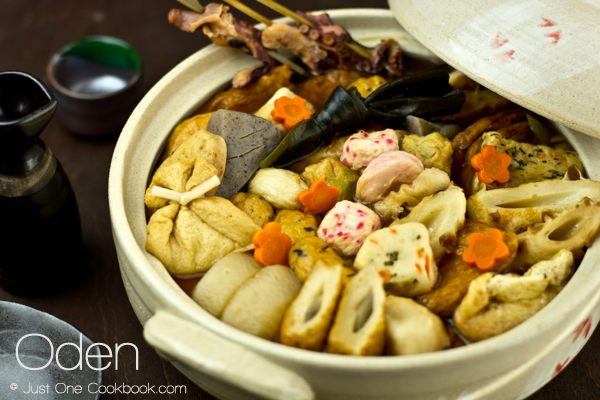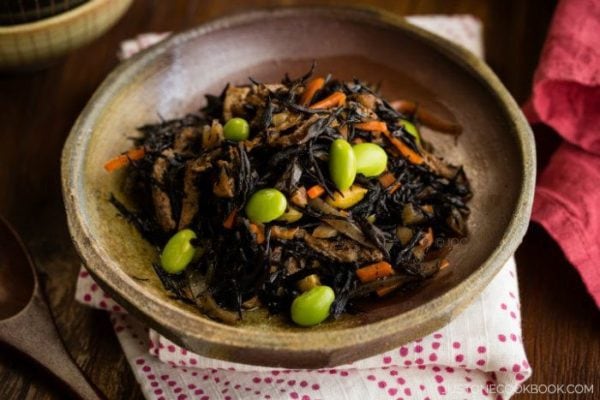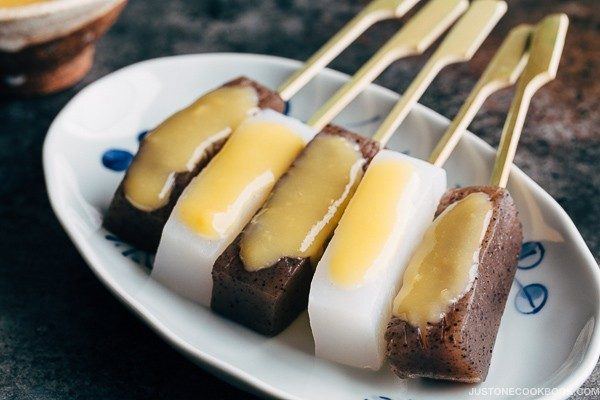Konnyaku is a rubbery, flavorless, zero-calorie, gluten-free, low carb food made of yams high in fiber and added to various Japanese foods for its squishy texture.

Konnyaku (こんにゃく), also known as yam cakes, is a Japanese food product made from Konjac or devil’s tongue. It’s made of a yam/taro in the genus Amorphophallus. It has a gelatinous texture devoid of flavor, and the color can either be gray with specs or white. It comes in different shapes, such as slabs, noodles, or balls.
Table of Contents
What is Konnyaku?
Konnyaku is a rubbery, jiggly food with almost no calories, sugar, fat, or protein. Consisting of water (97%), pulverized konnyaku powder, and seaweed powder, it’s high in glucomannan, a dietary fiber with a unique bouncy texture. While it lacks flavor and calories, it soaks up flavors in oden, sukiyaki, and simmered dishes.
The plant is native to warm subtropical to tropical eastern Asia, from Japan and China south to Indonesia. Since the sixth century, the Japanese have consumed it as a medicinal food. In recent years, it has been embraced by the keto community.
While most Japanese people buy it at the supermarket, you can also make it.
Different Types of Konnyaku
- Ita-Konnyaku (板こんにゃく) is a thick grey slab of konnyaku
- Ito-Konnnyaku (糸こんにゃく) or Shirataki noodles (白滝) are konnyaku noodles. It can either be grey or white. It is used in Kansai (Osaka) area, and shirataki is used in Kanto (Tokyo) area.
- Tama Konnyaku (玉こんにゃく) are grey or white ball-shaped. It’s a local food of Yamagata (northwest Japan).
- Aka Konnyaku (赤こんにゃく) is red konnyaku that’s a specialty of Shiga (central Japan).
- Sashimi Konnyaku (刺身こんにゃく) are presliced konnyaku eaten like sashimi with a miso sauce or soy sauce. It’s green or yellow.
- Snack konnyaku are flavored konnyaku. You can find konnyaku drinks in pouches or single-serving jelly packets.

Grey vs. White Konnyaku
Konnyaku is made by peeling, drying, and grounding the konjac root into powder. The powder is mixed with water and a coagulating agent to make firm cakes.
The color difference is due to the ingredients. Grey konnyaku includes seaweed powder, which gives its dark color. Initially, it was made with raw yam, so it had a natural brown/grey color from the yam skin. Nowadays, it is made with processed powder, but adding seaweed powder mimics the original production method.
You will find grey konnyaku across Japan and white konnyaku in northern Japan.

What Does Konnyaku Taste
It’s so mild that it doesn’t taste like anything, which may be puzzling initially. But it can soak up some flavors and take on a mouthfeel, like mushrooms. It’s also light on the stomach and thus prized as a diet food in Japan.
How To Cook Konnyaku
Before using konnyaku or shirataki in your recipe, parboil or rub it with salt. While you can skip this step, it helps remove smell, absorb more flavors, and improve texture. There are two ways to prep it.
Cook from cold water: Konnyaku loses more moisture with this method. Hence, the texture will be firmer and chewier. Once boiling, cook for 2-3 minutes and drain.
Cook in boiling water: Boil for 2-3 minutes. The unique smell will disappear, making the texture more jiggly and tender.
Rinse in water: For shirataki, give it a quick rinse in running water for a few seconds to remove the smell.
Recipes Using Konnyaku
Where to Buy Konnyaku
You can find konnyaku and shirataki at Japanese or Asian grocery stores and some health stores. Store the packages in the fridge. It will last for 30-90 days if unopened.
How to Choose the Best Konnyaku
First, check the texture by lightly pressing it. It should be firm with some bounce. Most are made of konjac powder imported from China. The most expensive konnyaku is grated raw konjac, although this may be difficult to find outside Japan.
How to Store
Submerge leftovers in the reserved liquid and store them in the refrigerator for up to a month. The liquid is alkaline water, which has a higher pH level than plain tap water and prevents bacterial contamination.
If you throw away the liquid, submerge the block entirely in water and refrigerate for 1-2 weeks, changing the water every 2-3 days.

Substitutions
There is no good substitute that has similar nutritious benefits.
You could replace shirataki with harusame noodles or other noodles, but it won’t have a zero-calorie high-fiber content.
Health Benefits
Konnyaku is a great source of vitamins and minerals like potassium, calcium, magnesium, phosphorus, iron, and zinc. In addition, dietary fiber slows down the body’s sugar intake when eaten with other food. It also lowers blood pressure and helps control cholesterol levels.
The nutritional benefits won’t change if it’s eaten as is or cooked.
FAQs
Q: Can I freeze konnyaku?
As it consists mainly of water, freezing will change the bouncy texture. It’ll become spongy even if you reconstitute it in water.
However, you can use it as a meat replacement for stir-fries, soups, and stews. It’ll absorb flavors more. When freezing konnyaku, cut it into cubes or slices beforehand to add directly to your cooking.
Q: Can I use shirataki as a replacement for noodles?
You can swap shirataki for ramen, udon, pasta, or japchae noodles. It does have that characteristic chew and won’t completely fool you, but it’s full of fiber and nutrients.
Wish to learn more about Japanese cooking? Sign up for our free newsletter to receive cooking tips & recipe updates! And stay in touch with me on Facebook, Pinterest, YouTube, and Instagram.














